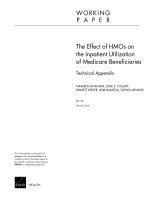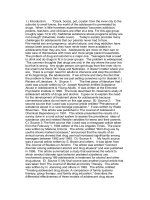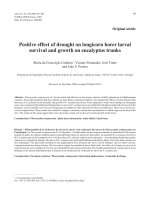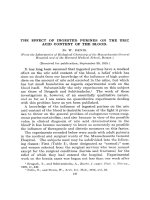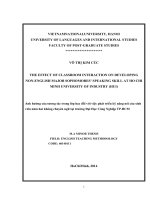Effect of hydrothermal pre-treatment on snake gourd seed shelling
Bạn đang xem bản rút gọn của tài liệu. Xem và tải ngay bản đầy đủ của tài liệu tại đây (479 KB, 11 trang )
Int.J.Curr.Microbiol.App.Sci (2019) 8(2): 1848-1858
International Journal of Current Microbiology and Applied Sciences
ISSN: 2319-7706 Volume 8 Number 02 (2019)
fig
Journal homepage:
Original Research Article
/>
Effect of Hydrothermal Pre-Treatment on Snake Gourd Seed Shelling
D.O. Idowu1*, S.A. Olaoye2, E.O. Owolabi3 and J.M. Adebayo4
Department of Agricultural Engineering, Ladoke Akintola University of Technology,
Ogbomoso, Nigeria
*Corresponding author
ABSTRACT
Keywords
Hydrothermal,
Wetting time, Seed
drying temperature,
Shelling efficiency,
Breakage
percentage
Article Info
Accepted:
15 January 2019
Available Online:
10 February 2019
Shelling is a fundamental unit operation during oil extraction of snake gourd seed oil. Lack
of proper and efficient method of shelling the seed has been identifying as a major problem
in the production and utilization of snake gourd seed oil. Currently manual method is
popular which is cumbersome, time consuming and not efficient for the process. Seed
pretreatment is required prior to shelling operation for some crops like snake gourd. Effect
of hydrothermal pretreatment was evaluated on the shelling efficiency, percentage
unshelled and percentage broken of the seed. The evaluations were done using a 2 by 3 by
5 factorial experiment. The two factors and their levels are soaking time (10, 20, 30, 40,
and 50 minutes) and seed drying temperature (60, 70, 80, 90, and 100 °C). The result of
the experiment shows that the highest shelling efficiency of 82.11% was achieved when
the wetting time was 60 minutes and the seed drying temperature was 100 °C while the
least efficiency (47.4%) was recorded when the wetting time was 10 minutes and seed
drying temperature was 60°C. The highest percentage unshelled (49.1%) was recoded at
10 minutes soaking time and 60°C seed drying temperature. It was observed that the
broken percentage decreased from 11.9 to 6.15% as the drying temperature decrease from
100 to 60°C. In conclusion, it was observed that the higher the soaking time and drying
temperature the higher the shelling efficiency and the lower the unshell percentage.
Introduction
Snake gourd plant (Trichosanthes cucumerina
L) is a tropical or subtropical vine that climbs
up tree and unfurls the flowers and fruits to
hang down to the ground (1). It is very
popular in Asia, Africa, Australia, Europe,
and South America (2). In Nigeria it is known
as snake tomato, pathakaya in India, pakupis
in Philippines, buapngu in Thailand,
pudalanka in Tamil, paduvalakaayi in
kannada and padavalanga in Malayam. The
kernels contain soft endosperm which has
been proved to be a good source of vegetable
oil (3; 4). Postharvest operation is an essential
unit operation in an agricultural production
and improves the usability of agricultural
products. Removal of the seed coat from the
kernel is very tedious when manual method is
used. Shelling of oil bearing seed before oil
expression has been proofed to be of great
advantage like better quality and quantity of
both raw oil (low wax content) and meal
1848
Int.J.Curr.Microbiol.App.Sci (2019) 8(2): 1848-1858
(higher protein content), and also increases
the life span of the oil extraction machine (5;
6 and 7). (8) reported an increase in oil
extracted from Jatropha curcas seed as the
percentage of dehusk seed decreases. The
treatment of some seed hydrothermally has
been reported to improve their percentage of
decortications. Many seeds like melon and
sunflower seed decortications were carried
out at a certain moisture content to have high
decortications percentage (9). Shelling
operation was found to depend on moisture
content. (1)reported that as moisture content
increased from 7 to 10% the shelling
efficiency of melon seed shelling machine
also increase from 45 to 99 %. Evaluation of
shelling process of some industrial crops such
as safflower (10) cotton seed (11), sunflower
seed (12) and moringa seed (13) has been
reported. However, the preliminary research
has shown a great opportunity by using
mechanical method after a hydrothermal
pretreatment of the seed. Hydrothermal
treatment involves soaking the seed in water
for specific time and then dried it at a
specified temperature. This method of pretreatment with varying degrees has been
applied to some crops like millet (14) and rice
(15).
In resent time, research work had been done
on physical properties of snake gourd (16)
and also effect of washing kernel on color and
rheological property of snake gourd oil (3) but
no work has been done on the effect of
hydrothermal pretreatment on snake gourd
decortication, hence, the study was done.
Nigeria. The seeds were clean to remove
immature and damaged seeds before using
them for the studies. A snake gourd sheller
(Fig. 1) that was developed at the same
department was used for the evaluation.
The experimental procedure
5 kg of snake gourd seed was steeped in distil
water for a specified time (10, 20, 30, 40 and
50 minutes). The seeds were removed after
the specified time and then spread in a steel
tray in about 2.5 cm bed thickness and dried
in an oven at a specified temperature (60, 70,
80, 90, and 100oC) with uniform drying time
of 20 minutes each. The samples were then
shelled and separated into shelled, unshelled
and broken kernel which was used to
calculate the shelling efficiency of the
machine.
Evaluation of the machine
The effect of hydrothermal pretreatments of
snake gourd seed on shelling was studied
under the following headings: Effect of
Soaking Time and Seed Drying Temperature
on the Shelling efficiency of the machine,
percentage unshelled and percentage broken
of kernel.
Machine efficiency
The effect of hydrothermal pretreatment on
seed shelling efficiency of the machine was
calculated from Equation 1 adapted from (18).
(1)
Materials and Methods
Material sample collection
The snake gourd seeds used were obtained
from the Department of Agricultural
Engineering, Ladoke Akintola University of
Technology demonstration farm, Ogbomoso,
Where
is machine efficiency (%),
is
percentage kernel recovery,
and K represents the percentage of kernel in
seed at the time of shelling.
(2)
Where k is the percentage of kernel in seed at
1849
Int.J.Curr.Microbiol.App.Sci (2019) 8(2): 1848-1858
time of shelling,
is mass of seed in 100g and
mass of kernel in 100g
Note: k was found to be 54.3%
is the
Percentage of unshelled kernel
Equation 3 was used to calculate the
percentage unshelled.
(3)
Where
is percentage unshelled (%)
is mass of unshelled seed (g) and
total mass of seed (g)
is
Percentage of broken kernel
To calculate the broken percentage Equation
4 was used
This was calculated from Equation
(4)
the shelling and breakage percentage of the
machine. Response surface methodology
(RMS) was used because of its advantages
which include reduction of experimental runs
needed to give adequate information for
statistical acceptability results, also its ability
to assess the relationship between the
responses and the independent variables and
define the effect of the independent variables,
alone or in combinations. The advantages also
include comprehensive experimental design
and mathematical modeling through the
partial regression fitting of the mathematical
modeling. The software was also used to
determine the coefficient of determination for
the models. Excel 2013 was used to draw
histogram to show the relationship between
the two factors.
Results and Discussion
Effect of hydrothermal pretreatment of
snake gourd seed on shelling efficiency of
an impact snake gourd shelling machine
The results of the effect of soaking time and
seed drying temperature pretreatment on
shelling efficiency and breakage percentage
of an impact sheller, design at Ladoke
Akintola
University
of
Technology,
Ogbomoso is as presented below.
Where:
TB is Percentage shelled
MB is mass of whole cotyledons
MC is mass of broken cotyledon
Experimental design
The two factors selected for the hydrothermal
pretreatment of seeds before shelling are
soaking time (which resulted in differential
moisture content) and seed drying
temperature. Table 1 shows the five-level two
factor that was used for the evaluations. These
factors were used in investigating the shelling
efficiency of the machine.
Statistical analysis
The Design Expert version 6.0.8 of 2002 was
used as statistical tool to evaluate main and
the interactive effects of these factors on both
Effect of Soaking Time and seed drying
temperature on shelling Efficiency of the
machine
The results of the experiment on the effect of
soaking time on the decorticating efficiency
of the machine were as shown in Table 2. The
decorticating efficiency of the machine was
observed to increase as the soaking time and
seed drying temperature increased (Fig. 2).
The highest decorticating efficiency of
82.11% was observed when the soaking time
was 50 minutes, seed drying temperature of
100 °C and machine speed of 461rpm, while
1850
Int.J.Curr.Microbiol.App.Sci (2019) 8(2): 1848-1858
the lowest decorticating efficiency of 47.3%
was recorded at 10 minutes soaking time, 60
°C seed drying temperature and 461rpm
machine speed. These results follows the
same trend as reported by (19), who recorded
efficiency of 71% at 7 min. of soaking time
and 54% efficiency at 5 min. of soaking time.
Also, (12) recorded the highest decorticating
efficiency of 70.14% at 20 min. soaking time
and lowest decorticating efficiency of 37.87%
at 0 min of soaking time. The results of the
experiments showed that as the hydrothermal
pre-treatment increased the shelling efficiency
of the machine also increased
Statistical analysis of the
hydrothermal
pretreatment
efficiency of the machine
effect of
on
the
The results of the experiments were fixed into
Design Expert version 6.0.8 software for
statistical analysis. The analysis showed that
the two factors investigated (soaking time and
seed drying temperature) and their
interactions were significant (p < 0.05) (Table
3) on the shelling efficiency.
The empirical model relating the soaking time
and seed drying temperature to predict the
shelling efficiency of the machine is as
presented in Equation 5.
(R2=0.8435)
(5)
Where,
is shelling efficiency (%)
drying temperature (◦ C)
is soaking time (min.)
Effect of drying temperature and soaking
time on the percentage seed unshelled
The results of the experiment show that the
percentage unshelled varies inversely with
seed drying temperature and soaking time.
The highest unshelled (49.1%) was observed
when the soaking time was 10 min. at 60 °C
drying temperature while the lowest
percentage unshelled (6.4%) was recorded at
50 minutes soaking time when the seed drying
temperature was 100 °C at 461 rpm hammer
speed. The higher the soaking time and seed
drying temperature the lower the percentage
unshelled of the machine (Table 4). The
percentage unshelled increased as the soaking
time and seed drying temperature reduced
(Fig. 3). This was in agreement with the
report of (20) that reported highest unshelled
efficiency (13.5%) for canola seeds when
soaked in distilled water for 100 minutes
followed by hot air drying at 65 °C. Also, (21)
recorded the highest percentage of
undepulped seed at 9 % at 15 minutes of
soaking time, while the lowest percentage of
undepulped seed was 1% at 75 minutes of
soaking time.
Statistical analysis of the effect of
hydrothermal
pretreatment
on
the
percentage unshelled of the machine
The results of the experiments were fixed into
Design Expert version 6.0.8 software for
statistical analysis. The analysis showed that
the two factors investigated (soaking time and
seed drying temperature) and their
interactions were significant (p < 0.05) (Table
5) on the percentage unshelled. The empirical
model relating the soaking time and seed
drying temperature to predict the percentage
unshelled of the machine is as presented in
Equation 6.
(R2=0.9925) (6)
Where,
is percentage broken (%)
drying temperature (°C)
is soaking time (min.)
1851
Int.J.Curr.Microbiol.App.Sci (2019) 8(2): 1848-1858
Table.1 Five-level, two factors hydrothermal pre-treatment on snake gourd decortication
Factors
Soaking Time (min.)
Drying Temperature (°C)
10
60
Levels
20
80
20
70
40
90
50
100
Table.2 Effect of soaking time and seed drying temperature on the shelling efficiency of the
machine
Evaluation
DT (°C)
Shelling efficiency
Soaking Time (minutes)
10
20
30
40
50
60
47.3
48.8
50.33
51.88
54.56
70
54.1
55.63
57.1
60.10
60.43
80
61.70
63.23
64.30
66.54
67.65
90
68.32.33
69.83
70.32
71.89
74.33
100
75.18
76.86
78.44
69.88
82.11
Average of three experimental runs
Table.3 Analysis of variance table for response surface model of the effect of the seed
hydrothermal pretreatment on shelling efficiency of the machine
Source
Model
DT
SA
DTSA
Residual
Cor Total
Sum of Squares
1714.75
110.70
1597.22
1.21
1.20
1715.96
DF
3
1
1
1
9
12
Mean Squares
571.59
110.70
1597.22
1.21
0.13
F Value
4288.62
830.57
11985.89
9.08
Prob > F
< 0.0001
< 0.0001
< 0.0001
< 0.0146
Table.4 Effect of soaking time and seed drying temperature on the percentage unshelled of the
machine
Evaluation
% Unshelled
DT (°C)
Soaking Time (minutes)
10
20
30
40
50
60
49.1
47.4
55.4
54.0
41.77
70
40.13
39.00
37.20
35.3
34.5
80
32.30
29.10
29.00
26.2
24.44
90
24.2
23.3
19.5
18.5
15.76
100
17.6
14.3
11.2
9.07
6.4
Average of three experimental runs
1852
Int.J.Curr.Microbiol.App.Sci (2019) 8(2): 1848-1858
Table.5 Analysis of variance table for response surface model of the effect of the seed
hydrothermal pretreatment on percentage seed broken of the machine
Source
Sum of Squares
DF
Mean Squares
F Value
Prob > F
Model
1674.09
3
558.03
1036.40
< 0.0001
DT
113.63
1
113.63
211.04
< 0.0001
SA
1551.09
1
1551.09
2880.77
< 0.0001
DTSA
3.74
4.85
1
9
3.74
0.54
6.95
< 0.0270
Residual
Cor Total
1678.94
12
Table.6 Effect of soaking time and seed drying temperature on percentage breakage of the
machine
Evaluation
DT (°C)
Breakage
percentage
Soaking Time (minutes)
10
20
30
40
50
60
6.1
5.8
5.4
5.0
5.0
70
6.8
6..3
6.0
5.8
5.5
80
7.5
6.8
6.6
6.5
6.5
90
9.9
8.3
7.8
7.6
7.5
100
11.9
10.8
10.6
9.9
9.6
Average of three experimental runs
Table.7 Analysis of variance table for response surface model of the effect of the seed
hydrothermal pretreatment on percentage broken of the machine
Source
Sum of Squares
DF
Mean Squares
F Value
Prob > F
Model
47.10
5
9.42
104.19
< 0.0001
DT
3.03
1
3.03
33.49
< 0.0007
SA
33.01
1
33.01
365.09
< 0.0001
DT2
0.26
1
0.26
2.92
< 0.1313
WT2
3.34
1
3.34
36.91
< 0.0005
DTSA
1
7
0.36
0.09
3.98
< 0.0802
Residual
0.36
0.63
Cor Total
47.73
12
1853
Int.J.Curr.Microbiol.App.Sci (2019) 8(2): 1848-1858
Fig.1 The snake gourd sheller
Fig.2
1854
Int.J.Curr.Microbiol.App.Sci (2019) 8(2): 1848-1858
Fig.3
Fig.4
1855
Int.J.Curr.Microbiol.App.Sci (2019) 8(2): 1848-1858
Fig.5 Complexity plot of NADH
Effect of drying temperature and soaking
time on the percentage seed brakeage
The results of the experiment on the effect of
hydrothermal pretreatment on the broken
percentage of shelled snake gourd seed was as
presented in Table 6. The pecentage broken
kernel decreases as the soaking time
increases. The least broken percentage was
achieved when soaking time was 50 minutes
and drying temperature was 60°C while the
highest broken percentage was recorded when
the soaking time was 60 minutes. This result
was in agreement with the report of (22) for
Jatropha fruit decortications and (23) for shea
butter craking they both reported decrease in
broken percentage with increase in moisture.
It was observed that the higher the seed
drying temperature the higher the broken
percentage (Fig. 4).
Statistical analysis of the effect of
hydrothermal pretreatment on the broken
percentage of the machine
The results of the experiments on the effect of
drying temperature and soaking time on the
broken percentage during shelling of snake
gourd were fixed into Design Expert version
6.0.8 software for statistical analysis. The
analysis showed that the two factors
investigated (soaking time and seed drying
temperature) and their interactions were
significant (p < 0.05) (Table 7).
The regression model representing the
relationship between wetting time and drying
temperature is as shown in Equation 7.
(R2=0.9867)
(7)
Where,
is percentage broken (%)
drying temperature (°C)
is soaking time (min.)
In conclusion, the effect of seed pretreatment
on shelling efficiency and broken percentage
was evaluate using hydrothermal pretreatment
(soaking time and seed drying temperature).
The result shows that both the soaking time
and the drying temperature were very
1856
Int.J.Curr.Microbiol.App.Sci (2019) 8(2): 1848-1858
significant on shelling efficiency, unshell
percentage
and
broken
percentage
investigated. It is there for recommended that
during optimization of the snake gourd seed
shelling hydrothermal pretreatment of the
seed should be taking into consideration.
8.
References
1.
2.
3.
4.
5.
6.
7.
Kissan.M,
(2006)
Snake
gourd
(Trichosanth cucumerina) of seed and
cultivation,
weed
Management,
harvesting
disease
and
pest
management. Farmer database, pp. 110.
Robinson R.W. and Decker-Walkers,
D.S, (1997): Appendix common
cucurbit name and their scientific
equivalents
in
cucurbits.
CAB
international, USA.
Idowu D O. (2015) A study on the
effect of washing kernel on yield color
and a rheological properties of snake
gourd oil. Journal of Agricultural
Technology. 11(4: 811-822).
Folarin. O.M., Enikanoselu, ON.
(2010).Evaluation of the effect of
temperature on the stability of metal
soaps Trichosanthes cucumerina seed
oil. Journal of Applied, Science and
Environment, 14 (3): 69-79.
Figuiredo, A.K., Rodriguez, L.M.,
Lindstrom L.I., Riccobene I.C., and
Nolasco, S.M. (2013), performance
analysis of a de-hulling system for
safflower grains. Industrial crops and
product, 43(5): 311-317.
Figuiredo, A.K., Rodriguez, L.M.,
Riccobene I.C., and Nolasco, S.M.
(2014). Analysis of the performance of
a dehulling system for confectionary
sunflower seeds, Food and Nutrition
science, 5(6): 541-548.
Kate, A.E, Lohani, U.C,. Pandey J.P
Shahi N.C. Sarkar A. (2014).
Traditional and mechanical Method of
the oil extraction from wild apricot
9.
10.
11.
12.
13.
14.
1857
kernel: a comparative study. Res. J.
Chem. Env. Sci. Vol 2 (2) April. 54-60.
Wim, D.G., Maes, J., Smons, B.,
Balshaw.,C and Miles, D. (2007).
Improved yield and biodiesel quality
from Jatropha curcas by optimized
seed processing and oil pre- treatment.
Proceedings of the AOCS. International
congress on biodiesel, Viena, Austria.
Pg. 5-7.
Oluwole, F.A. Abudulram, A.T., Aviara
N.A., and Nana, S.N. (2012).
Traditional method of Extracting castor
oil. Continental Journal of Engineering
science. 7 (2) 6-10.
Ting, R.P., Peralta E.V.C., Elauria, J.C.,
2012.
Design,
fabrication
and
optimization of jatropha sheller.
International journal of optimization
and control theories and application, 2
(2): 113-127.
Nunneley, J.L., Faulkner, W.B.,
Shimek,
M.V.,
Holt,
G.A.,
Wedegaertner, T.C. 2012. Optimization
of a cottonseed dehulling process to
yield intact seed meals. Applied
Engineering in Agriculture, 29 (5):613619.
Aremu, A.K., Adeniyi, A.O. and
Fadele, O.K. 2015. Development and
performance of a jatropha seed shelling
machine based on seed moisture
content.
Journal
of
biosystem
Engineering, 40(2): 137-144.
Fadele, O.K. and Aremu, A.K. (2017).
Performance evaluation of some
tangential impact shelling device for
moringa seed shelling. Agricultural
Engineering CIGR.E Journal, 19(4);
170-180.
Malleshl N.G., (2007). Nutritional and
technical features of ragi (finger millet)
and processing for value addition in
food uses of small millet and avenues
for further processing and value
addition. Bangalore project coordinating
Int.J.Curr.Microbiol.App.Sci (2019) 8(2): 1848-1858
15.
16.
17.
18.
19.
20.
cell. All India coordinated small millet
improvement
project
ICAR,
UAS,GKVK. Pg 9-19.
Kimura, T., Bhattacharya, K.R., Ali,
S.Z (1993). Effect of processing
condition on the colour intensity of
parboiled rice. Journal of Science,
AgricStruct. 24:23-30.
Idowu, D.O. and Owolarafe, O.K.
(2013) A study of some hydroaerodynamic properties of snake gourd
(Trichosantes cucumerina. L) seed,
kernel and chaff. Journal of Agricultural
Technology, 9(7):1691-1701.
Idowu D.O. and Owolarafe, O.K.
(2014). Physical properties of snake
gourd seed (Trichosantes cucumerinaL)
relevant in grading and separation.
Agric. Eng. Int: CIGR Ejournal, 16 (1):
303-312.
Amoah, F. (2013). Modification and
Evaluation of a groundnut cracker for
cracking Jatropha seeds. A M.Sc. thesis
at
the
Department
Agricultural
Engineering,
Kwame
Nkrumah
University of science and Technology,
Ghana.
Olusegun, A.D. and Adekunle A.S.
(2008). The design, construction and
testing of melon sheller. Global journal
of engineering and technology 1
(4):360-368).
Mohamadzadeh, J., Sadeghi-Mahoonak,
A., Yaghbani M. and Aalami M.,
(2009). Effect of Hydrothermal pre-
efficiency and oil quality. World journal of
dairy & food sciences 4(1) 14-18.
21.
22.
23.
24.
25.
26.
Olaoye J.O. (2012). Development of
small scale Equipment for depulpping
locust bean seeds. International Journal
of Engineering and Technology, 11(6):
173-186.
Pradhan, R.C., Naik, S.N., Bhatnagar, N
and Vijay, V.K. (2010). Design,
development and testing of hand
operated decorticator for jatropha fruit.
Applied Energy 87 (3):762- 768.
Oluwole, F.A., Aviara, N.A and Haque
M.A.
2004.
Development
and
performance evaluation test of sheanut
cracker. Journal of food Engineering 65
(1): 117-123.
Oluwole, F.A., Aviara, NA., Umar,
B.,and Mohammed, A.B. (2015).
Influence of variety and pre-treatment
on oil properties of mechanically
expressed castor oil. Journal of
Engineering
Technology
and
innovation. 4 (1):1-9.
C.D.K. Cook, B.J. Gupta, E.M.Rix, J.
Scheller, and M. Serrz, Water plants of
the world, Jurh, The Hague. Court, A.
B. (1957), Sundry notes on three
Victori, 1974.
A. Agrawal, M.N. Pandey, and G.P.
Dubey,
Management
of
mental
deficiency by an indigenous drug,
Brahmi
(Bacopa
monniera),
Pharmacopsychoecologia.,
Vol.6(1),
pp. 1-5, 1993.
treatment of canola seed on dehulling
How to cite this article:
Idowu, D.O., S.A. Olaoye, E.O. Owolabi and Adebayo, J.M. 2019. Effect of Hydrothermal PreTreatment on Snake Gourd Seed Shelling. Int.J.Curr.Microbiol.App.Sci. 8(02): 1848-1858.
doi: />
1858
